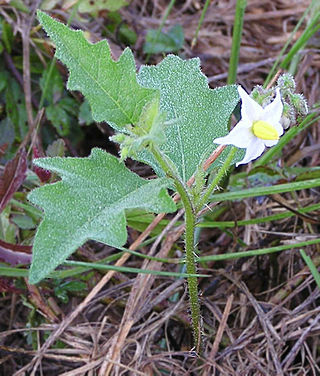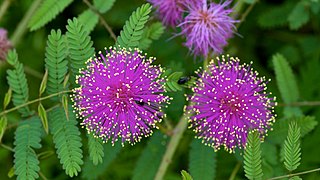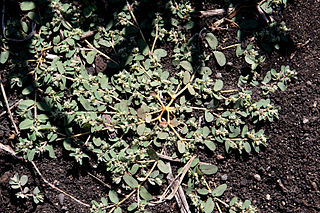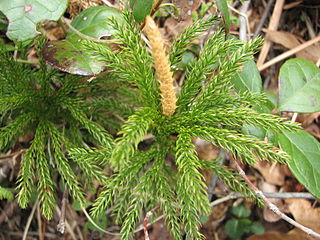
Mimosa is a genus of about 600 species of herbs and shrubs, in the mimosoid clade of the legume family Fabaceae. Species are native to the Americas, from North Dakota to northern Argentina, and to eastern Africa as well as the Indian subcontinent and Indochina. The generic name is derived from the Greek word μῖμος (mimos), 'actor' or 'mime', and the feminine suffix -osa, 'resembling', suggesting its 'sensitive leaves' which seem to 'mimic conscious life'.

Solanum carolinense, the Carolina horsenettle, is not a true nettle, but a member of the Solanaceae, or nightshade family. It is a perennial herbaceous plant, native to the southeastern United States, though its range has expanded throughout much of temperate North America. The plant is an invasive in parts of Europe, Asia, Africa and Australia. The stem and undersides of larger leaf veins are covered with prickles.

Rapid plant movement encompasses movement in plant structures occurring over a very short period, usually under one second. For example, the Venus flytrap closes its trap in about 100 milliseconds. The traps of Utricularia are much faster, closing in about 0.5 milliseconds. The dogwood bunchberry's flower opens its petals and fires pollen in less than 0.5 milliseconds. The record is currently held by the white mulberry tree, with flower movement taking 25 microseconds, as pollen is catapulted from the stamens at velocities in excess of half the speed of sound—near the theoretical physical limits for movements in plants.

Mimosa pudica is a creeping annual or perennial flowering plant of the pea/legume family Fabaceae. It is often grown for its curiosity value: the sensitive compound leaves quickly fold inward and droop when touched or shaken and re-open a few minutes later. For this reason, this species is commonly cited as an example of rapid plant movement. Like a number of other plant species, it undergoes changes in leaf orientation termed "sleep" or nyctinastic movement. The foliage closes during darkness and reopens in light. This was first studied by French scientist Jean-Jacques d'Ortous. In the UK it has gained the Royal Horticultural Society's Award of Garden Merit.

Mimosa nuttallii, the Nuttall's sensitive-briar, catclaw brier, or sensitive brier, is an herbaceous perennial legume in the subfamily Mimosoideae native to the central United States. It has a trailing semi-woody vine covered with small recurved prickles that can be painful to bare skin.

Neptunia lutea, commonly called the yellow-puff, is an herbaceous plant in the legume family (Fabaceae). It is native to the United States, where it is primarily found in the South Central region, extending eastward into the Blackland Prairies of Alabama and Mississippi. Its natural habitat is in open areas such as prairies and savannas. It is tolerant of disturbed soil.

Vachellia farnesiana, also known as Acacia farnesiana, and previously Mimosa farnesiana, commonly known as sweet acacia, huisache, casha tree, or needle bush, is a species of shrub or small tree in the legume family, Fabaceae. Its flowers are used in the perfume industry.

Mimosa pigra, commonly known as the giant sensitive tree, is a species of plant of the genus Mimosa, in the family Fabaceae.

Euphorbia maculata, known as spotted spurge, prostrate spurge, milk purslane, or spotted sandmat, is a fast-growing annual plant in the family Euphorbiaceae. It is native to North America, where it is generally considered a common weed, it can be found in disturbed soils such as garden beds, along railroad tracks, and in the cracks of sidewalks. It has become a common introduced species throughout the world, including Europe, Japan, Korea, Australia, and New Zealand.

Rhododendron macrophyllum, the Pacific rhododendron, California rosebay, California rhododendron, coast rhododendron or big leaf rhododendron, is a large-leaved species of Rhododendron native to the Pacific Coast of North America. It is the state flower of Washington.

Mimosa diplotricha is a species of leguminous woody shrub native to the Neotropics. It is an invasive species and now has a pantropical distribution. It is commonly known as the giant sensitive plant, giant false sensitive plant, or nila grass.

Quercus oblongifolia, commonly known as the Mexican blue oak, Arizona blue oak, Blue live oak or Sonoran blue oak, is an evergreen small tree or large shrub in the white oak group.

Mimosa strigillosa, also known as sunshine mimosa and powderpuff, is a perennial ground cover in the family Fabaceae that is native to nearly all US states bordering the Gulf of Mexico and grows north into Georgia and Arkansas as well. The name powderpuff refers to the small spherical flowers that rise above the plant's creeping vines. Like related species in the genus Mimosa, sunshine mimosa has sensitive leaves that can fold in a matter of seconds after being disturbed.

Kalmia microphylla, known as alpine laurel, bog laurel, swamp-laurel, western bog-laurel or western laurel, is a species of Kalmia of the family Ericaceae. It is native to North America and can be found throughout the western US and western and central Canada below the subarctic.

Luzula acuminata, the hairy woodrush, is a species of perennial flowering plant in the rush family, Juncaceae, that is native to the Eastern United States and Canada. It is 6–47 centimetres (2.4–18.5 in) tall with its basal leaves being of 6–39 centimetres (2.4–15.4 in) high and 2–11 millimetres (0.079–0.433 in) in diameter. It has cauline leaves are 2.5–11.5 centimetres (0.98–4.53 in) tall and 2–5 millimetres (0.079–0.197 in) wide.

Croton monanthogynus is a species of flowering plant in the spurge family. The undersides are gray. It is a summer annual that produces small, inconspicuous flowers. The plant is monoecious and has both male and female reproductive organs in separate clusters on the same plant. Its leaves are alternate. It is native to the southeastern United States and the southern Great Plains. It is considered adventive in more northern states. AL, AR, AZ, GA, IA, IL, IN, KS, KY, LA, MD, MI, MO, MS, NC, NE, OH, OK, PA, SC, TN, TX, VA, WI, WV.

Clethra acuminata, the mountain pepper bush, is a shrub native to the Appalachian Mountains of the southeastern United States. It has been reported from the states of Pennsylvania, West Virginia, Virginia, North Carolina, South Carolina, Georgia, Alabama and Tennessee, primarily from deciduous forests at elevations of 500–1,400 m (1,600–4,600 ft).

Oxypolis rigidior, known as cowbane, common water dropwort, stiff cowbane, pig-potato, and Cherokee swamp potato, is a species of flowering plant in the carrot family native to eastern North America. It is a perennial wildflower found in wet habitats. Oxypolis rigidior has been reported as being poisonous to some mammals, but it is also considered edible and safe by some authors.

Dendrolycopodium hickeyi known as Hickey's tree club-moss or Pennsylvania clubmoss, is a North American species of clubmoss in the family Lycopodiaceae. It is native to eastern and Central Canada and the eastern and north-central United States. The genus Dendrolycopodium is accepted in the Pteridophyte Phylogeny Group classification of 2016, but not in other classifications, which submerge the genus in a larger Lycopodium.

Mimosa quadrivalvis, known as fourvalve mimosa, sensitive briar and cat's claw, is a trailing vine native to North America, Central America, and the Caribbean. It is known as sensitive briar because the leaves fold when they are touched or disturbed.




















